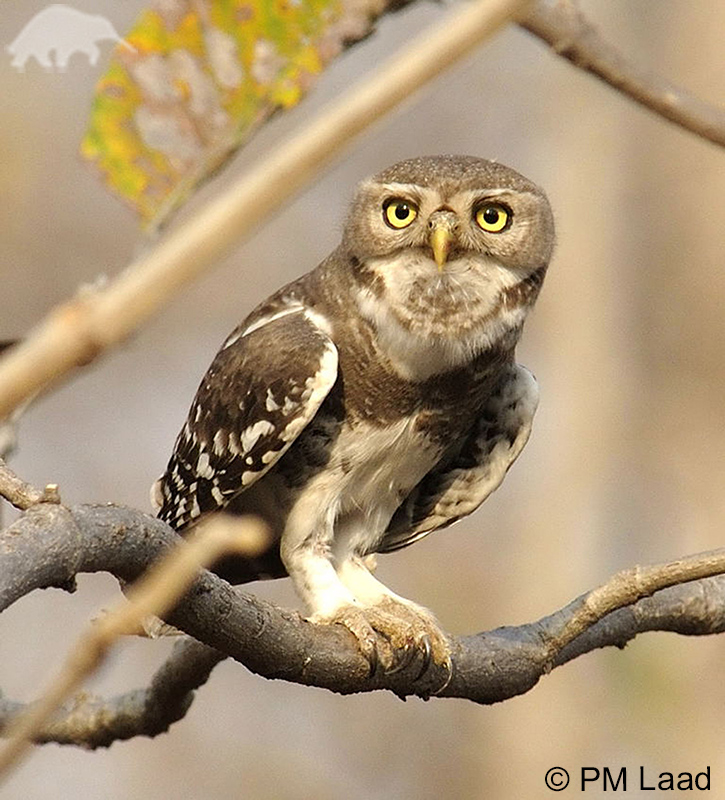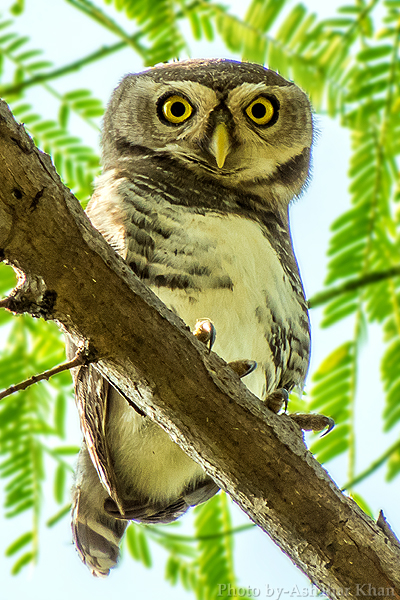One hundred and thirteen years after the last genuine record, the Forest Owlet, Athene blewitti, has been rediscovered in low foothills dry-deciduous forest north of Shahada in Maharashtra, India. This augurs well for the conservation of the species.
The town of Shahada is in the Tapi (Tapti) River Valley at about 150 m elevation. This valley, which is now almost entirely cultivated, extends to about 28 km north of Shahada. Here the valley meets the Akrani Hills, the westernmost portion of the Satpura Range. The lower parts of the hills is where the Forest Owlet has been sighted. The slope at the site itself is minimal to moderate, the area cut by dry ravines, and the soil there quite dry, rocky and well-drained.
The habitat is open secondary dry deciduous forest, consisting mostly of teak (Tectona grandis). There were a few scattered leafless large trees in November with little undergrowth. However, there was considerable grass undergrowth in the more open areas, indicating little or no grazing there. A few hundred metres both above and below the site were long wet ravines, with some standing water, a little running water, and richer forests of taller trees. Unfortunately, we did not find Forest Owlets in these more mesic areas, suggesting the possibility it may have a preference for drier forest.

How to identify the Forest Owlet?
- Rings tied to the legs. It is a common practice to ring forest owlets with microsatellite tags for tracking purposes.
- Color marking on the legs
- Identification with size & shape, color pattern, behavior and habitat. This is the most safe and suitable method as it will not harm the birds. Furthermore, the Forest Owlet is active in the morning hours also. Hence close observation for long hours with field glasses will give information of the difference between male and female birds and also difference among each bird. Long hours of field observation will give more information about the identification of owlets.

How is the Forest Owlet being conserved?
- Implementing Policy level in controlling the felling of Teak trees and protection of forest cover
- Awareness of forest dwellers in protection and promotion of forest cover
- Educating school children for protection and promotion of Forest Owlet Habitat
- Formation of Forest Protection Committees to monitor illegal felling of trees
- Protection and promotion of teak plantations as it will be the ideal habitat for Forest owlet
- Protection and promotion of grasslands and shrubs by involving forest communities that will be the habitat of grasshoppers, lizards, rodents and small birds/animals.
- Promotion of medicinal shrubs and fruit bearing shrubs that will bring additional income for the forest dwellers.
- Promotion of nests in trees for nesting of Forest owlets
The Forest Owlet is one of the numerous examples of rare species of birds reviving across India. Similar positive conservation stories are abundant in North East India. One can hope these case studies prove inspirational in saving struggling species, such as the Great Indian Bustard.
Written by: Keny J.Newport, Intern, Indian Institute of Science Education and Research, (Shola Sky Island Bird Project), Valparai, Coimbatore District
Help us Help Them! Think Wildlife Foundation is a non profit organization with various conservation initiatives. Our most prominent campaign is our Caring for Pari intiative. Pari is a rehabilitated elephant at the Wildlife SoS Hospital. 25% of the profits from our store are donated to the elephant hospital for Pari. Other than buying our wonderful merchandise, you could donate directly to our Caring For Pari fundraiser.
